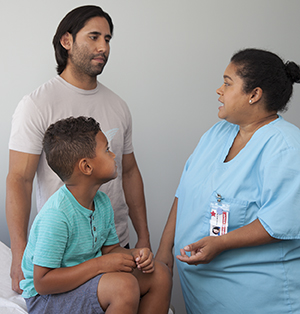Discharge Instructions for Anaphylactic Shock (Child)
Your child has been diagnosed with anaphylaxis. This is a serious kind of allergic reaction. It can happen within minutes of exposure to a substance or a trigger that causes an allergic reaction. Common causes of anaphylaxis in children are:
-
Pollen (grass, weeds)
-
Latex
-
High-intensity physical activity
-
Penicillin
-
Nuts and peanuts
-
Shellfish
-
Milk
-
Eggs
-
Stings from a yellow jacket or bee
-
IV (intravenous) contrast given during a CT scan
Contact with the substance through the skin or by eating it can cause a severe allergic reaction. Your child may have trouble breathing or talking. Your child may vomit, feel dizzy, or faint. They may have stomach pain, coughing, or wheezing. Your child may have swelling of the lips and tongue, or a red rash on the body (hives).
The reaction causes a drop in blood pressure. This can be very rapid. Because there is less blood flow from the drop in blood pressure, less oxygen reaches the brain and other organs. Your child then goes into shock. If it is not treated right away, anaphylactic shock can be fatal. Here’s what you need to know to protect your child.
Preventing an attack
You can help prevent an attack with these tips:
-
Know your child’s allergies or triggers. Make sure your child stays away from them. Anaphylactic shock can lead to death.
-
Tell your child’s healthcare provider, dentist, and pharmacist about any allergies your child has to foods and medicines.
-
Ask your child's healthcare provider if your child should see an allergist. This is a healthcare provider who focuses on treating allergies. Also ask if allergy shots (immunotherapy) will help your child.
-
When eating at restaurants, tell restaurant staff workers about your child’s food allergies before ordering your child's food. If your child has a food allergy, ask about ingredients and possible cross-contamination of foods.
-
Know which foods and medicines may cause a cross-reaction. Read the food and drug labels and their manufacturer information with care.
Using epinephrine
-
Ask your child’s healthcare provider to prescribe an epinephrine for your child, such as an epinephrine autoinjector or nasal spray. This is a single-dose kit of epinephrine (adrenaline). You can give your child the medicine to help stop the allergic reaction until medical help gets there. You should have 2 doses with your child at all times. Make an anaphylaxis action plan with your child's healthcare provider or allergist.
-
Learn how to give your child the epinephrine. If it makes you uncomfortable, remind yourself that you are saving your child’s life. Ask your child's healthcare team to show you how to use the epinephrine.
-
If your child is old enough, teach them to use the epinephrine.
-
Make sure you check the expiration date of the epinephrine.
-
Keep more than 1 epinephrine dose on hand. Carry 1 kit with you. Keep 1 at your child’s school or daycare center. Keep 1 at home where it’s easy to find.
-
Make sure your child's healthcare provider gives you instructions on how to train others to use the medicine. Give them to your child's school, daycare center, or babysitter.
Warning others
-
Have your child wear a medical ID bracelet. It should list your child's allergy and tell others what to do in an emergency. Ask your child's healthcare provider how to get this bracelet.
-
Tell your family, friends, and others what they should do if your child has a severe allergic reaction and you aren’t there:
-
Show them how to use the epinephrine.
-
Tell them to call 911 and to give your child a dose of epinephrine if they think your child is having a reaction.
-
Ask them to start CPR if your child stops breathing.
-
Tell them to make sure your child lies down with legs raised during the reaction.
-
Tell them to wash their hands and clean surfaces and utensils when preparing food.
Follow-up
Make a follow-up visit with your child's healthcare provider.
Continue giving the medicine as prescribed by your child's healthcare provider.

When to get medical help
Use the epinephrine and call 911 right away if your child has symptoms of anaphylaxis:
-
Drowsiness, fainting, or loss of consciousness
-
Racing pulse
-
Wheezing or trouble breathing
-
Shortness of breath
-
Nausea and vomiting
-
Swelling of the lips, tongue, or throat
-
Itchy, red, blotchy skin, rash, or hives
-
Pale, cool, damp skin
-
Confusion
-
Sneezing, congestion, or runny nose
-
Stomach pain or cramps